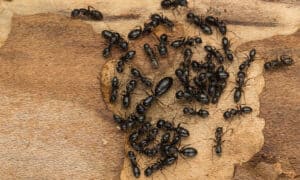Summer brings a fascinating spectacle — a bustling display of tiny creatures venturing out from their cozy hideouts to soak up the sun. With over 12,000 species of ants worldwide, it’s no surprise that ants are scattered everywhere in the state of New York. Let’s delve deeper into the types of ants that steal the show during the summertime in the Empire State.

1. Citronella Ant (Acanthomyops)
Citronella ants are a peculiar kind of pest that can be encountered by homeowners and businesses in New York. They get their name because of their ability to produce a lemony scent when they sense danger or get stepped on. These ants are small and typically have a bright yellow to orange-yellow color.
The workers of citronella ants are approximately ⅛ inch in length and exhibit a glossy brick-red or brownish-red hue. They have a single-segmented waist and lack a stinger. These ants feed on the honeydew produced by aphids and create their colonies in gardens, lawns, and near house foundations. The swarming ants commonly seen in New York are the winged ants of the colony, which leave their colonies to search for other colonies and to mate.
During the spring season, citronella ants begin to swarm and can become a significant disturbance both indoors and outdoors. Though they do not reproduce or cause harm inside a home, they can enter through small cracks in doorways or windows, causing homeowners to mistake them for termites and become alarmed.
The winged ants of the colony are most commonly observed in early spring (March and April) and in late September to October.
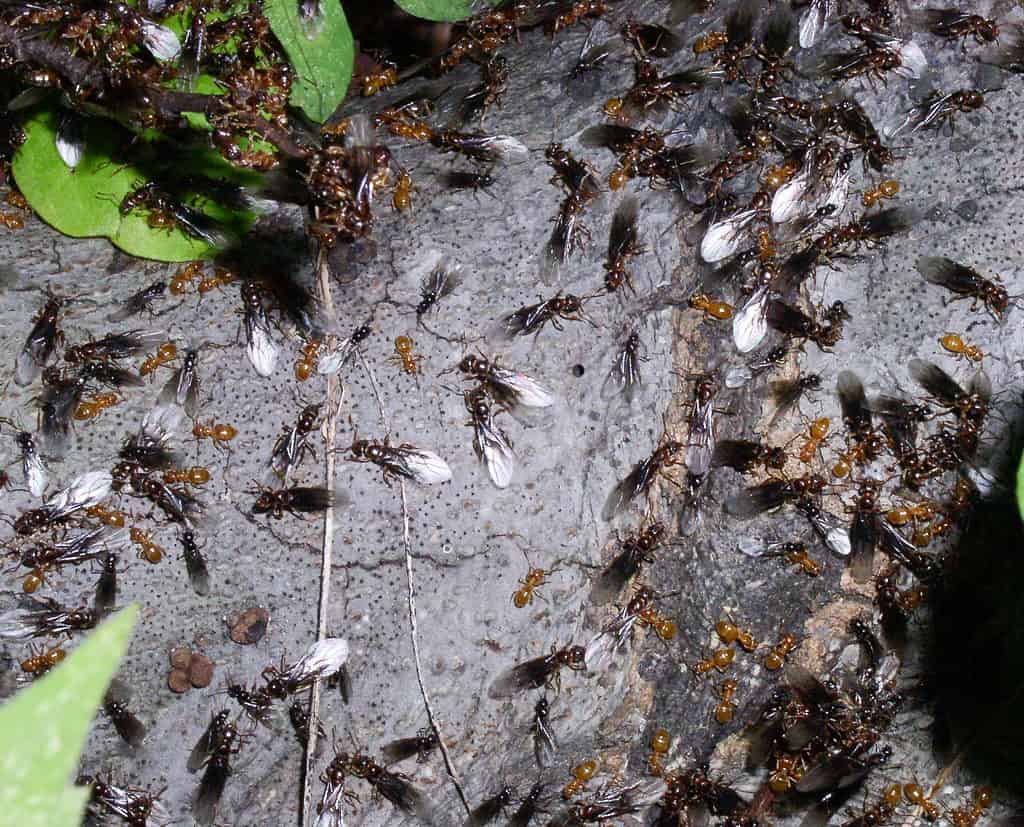
Citronella ants get their name because of their ability to produce a lemony scent when they sense danger or get stepped on.
©Beatriz Moisset / CC BY-SA 4.0 – License
2. Odorous House Ant (Tapinoma sessile)
Odorous house ants are a common sight in New York state, characterized by their dark brown color and small size of 1/16 to ⅛ of an inch.
These ants emit a pungent smell when squashed, which gives them their name. They often scavenge for food scraps inside households and live in colonies of several hundred members.
The adult odorous house ants are black or dark brown in color, with a waist that has a flattened node that may not be easy to see. These ants possess 12-segmented antennae without a prominent club. They tend to reside behind brick and siding walls, as well as in crawl spaces and wall voids. They have a taste for sweet foods, meat, and cheese, and their presence can lead to food contamination and unpleasant odors in homes.
These ants typically invade homes during wet weather as their primary food source, honeydew from insects, is washed away from vegetation. While they remain active throughout the year indoors, they tend to overwinter as larvae or workers outdoors until March. They retreat back into hiding by September or October.
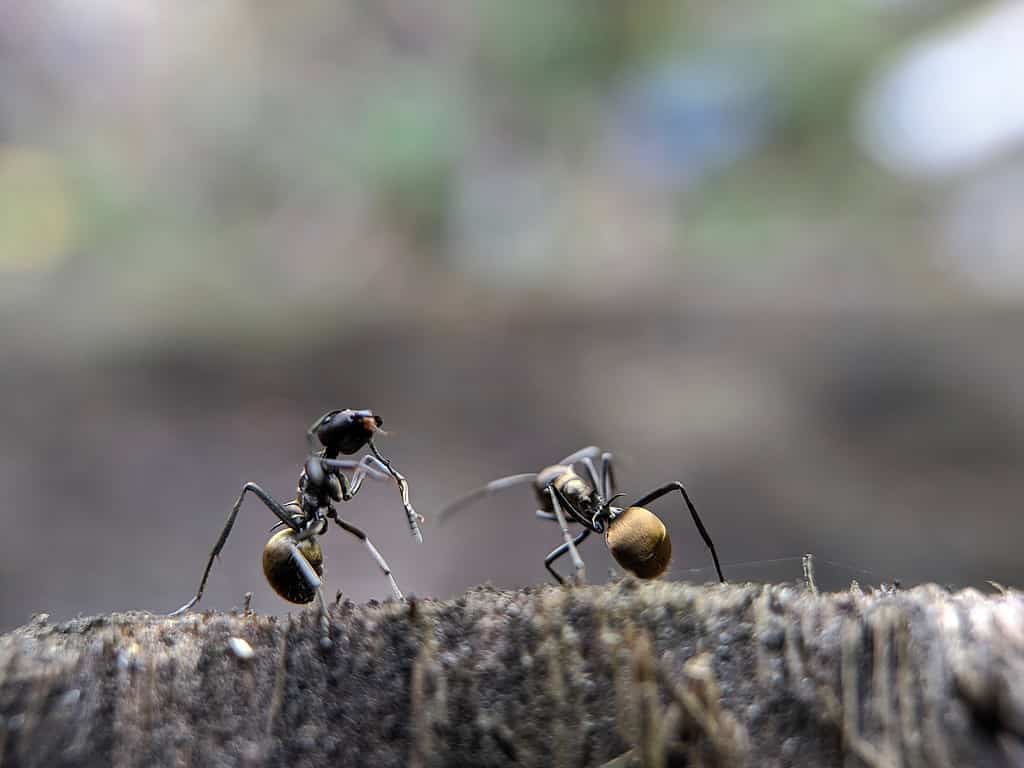
Odorous house ants emit a pungent smell when squashed, which gives them their name.
©Dhe Tong/Shutterstock.com
3. Argentine Ant (Linepithema humile)
Argentine ants are a fascinating species known for their impressive colonies and long-distance foraging habits. Unlike other ants, these tiny creatures have the ability to create colonies with thousands of workers and hundreds of queens!
Despite their impressive colony size, the workers of this ant species are monomorphic and measure around 1/8 inch in length. On the other hand, the queens are more varied in size, ranging from 1/6 to 1/4 inches in length, and have a uniform dark brown color. They move in well-organized trails and emit a slightly greasy, musty odor when crushed.
These omnivorous ants have a diverse diet that includes human and pet food, dead animals, feces, vomit, and even human sputum. They have a particular liking for honeydew, which is produced by insects like mealybugs, aphids, and whiteflies.
Argentine ants prefer to build their nests in damp environments close to a food source. You might find them outdoors constructing shallow nests under boards or stones, beneath plants, or along sidewalks.
Interestingly, Argentine ants were first introduced to the continental U.S. in New Orleans during the late 1800s from Brazil.
You’re most likely to see these ants out and about from May to September when the weather is warm.

Argentine ants are a fascinating species known for their impressive colonies and long-distance foraging habits.
©Victor Suarez Naranjo/Shutterstock.com
4. Acrobat Ant (Crematogaster)
Acrobat ants are aptly named for their ability to contort their abdomens over their bodies, almost like they’re performing acrobatics.
These ants are typically small to medium-sized, measuring between 1/16 to 1/8 inch long. They have highly reflective bodies that vary in color from light red to black or brown. Their most distinguishing feature is their heart-shaped abdomen, which is best observed from above.
When living outdoors, acrobat ants sustain themselves on honeydew from aphids, mealybugs, and other insects, both alive and dead. They can be found under rocks or within logs, firewood, and trees, preferring to build their nests in moist wood that’s been weakened by decay or fungi.
Occasionally, these ants may cause short circuits by stripping the insulation off electrical or telephone wires. They’re also known to release a potent odor when disturbed.
Swarmers, known as winged males and females, are produced by the acrobat ant. Between mid-June and late September, these winged ants are commonly observed in New York. These insects venture out from their colonies to mate, and the mated females eventually become queens of their own colonies.
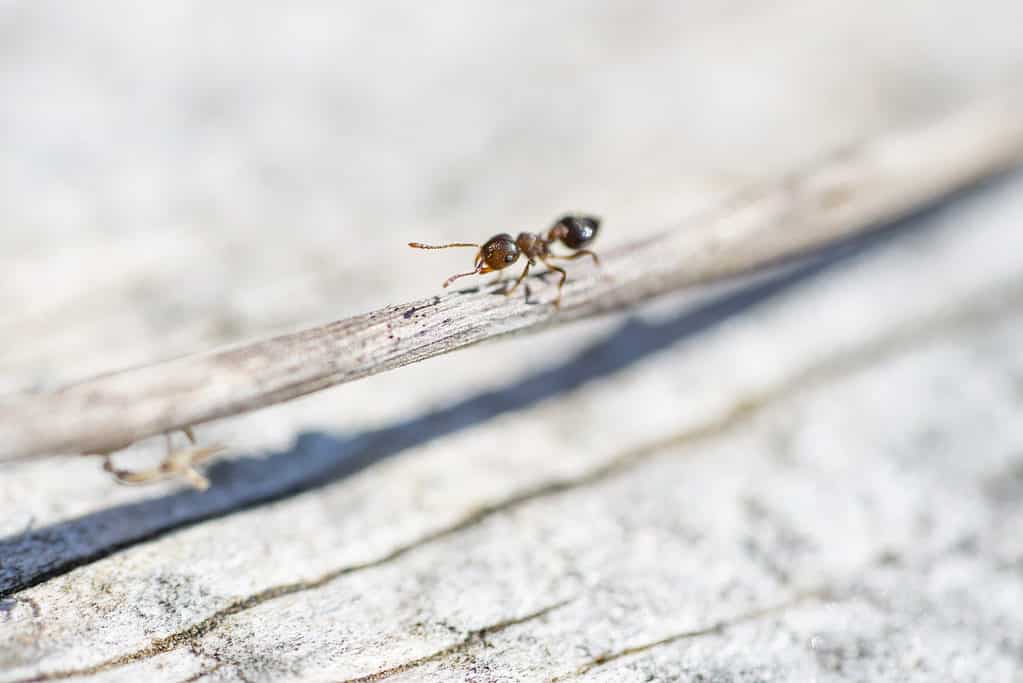
Acrobat ants have heart-shaped abdomens.
©iStock.com/ErikAgar
5. Carpenter Ant (Camponotus)
In New York, carpenter ants can be a nightmare for homeowners as they construct colonies in damp, decaying wood that can cause severe damage to buildings.
Identifying carpenter ants is relatively easy. They have narrow waists, bent antennae, dark bodies, and hind wings shorter than their front wings (when present). Their workers are light-colored with broad waists and straight antennae.
Workers from a single carpenter ant colony can vary in size, ranging from small 1/4 inch to large 1/2 inch, while the queen can grow as large as 3/4 inch. Although carpenter ants have a diverse appetite, they do not eat wood. Instead, they seek out protein and sugar sources, such as living and dead insects, honeydew, meats, pet food, syrup, honey, and more.
While carpenter ants typically nest in stumps, dead or decaying trees, branches, and logs, some species also nest in soil.
Carpenter ants are most active during the spring months, from March through April, and can remain active until September. A mature colony, at least two years old, will release reproductive winged queens and males during the spring season.
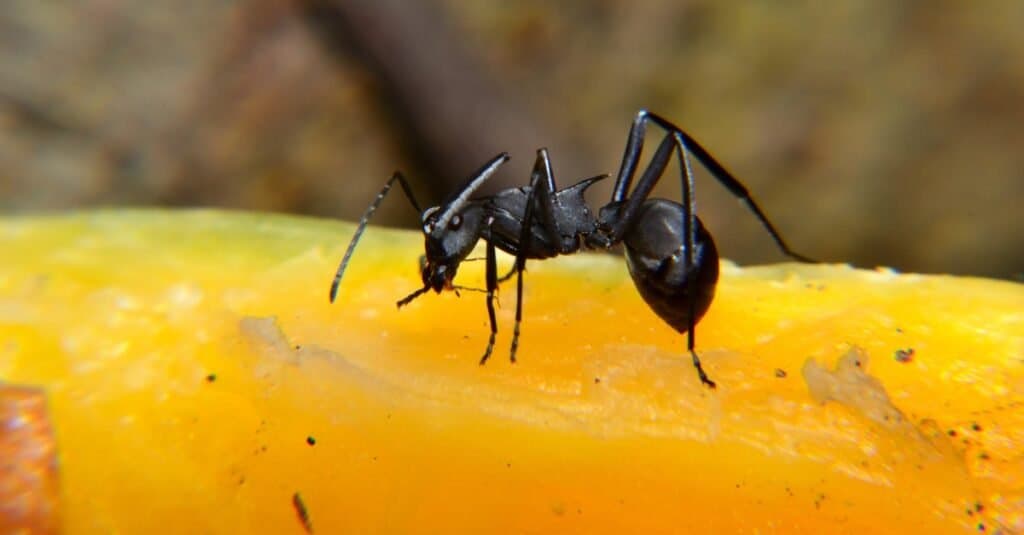
Carpenter ants can be a nightmare for homeowners as they construct colonies in damp, decaying wood that can cause severe damage to buildings.
©Kras_Stock/Shutterstock.com
6. Pavement Ant (Tetramorium caespitum)
Pavement ants are one of the most commonly encountered ant species in New York. They’re brown to black in color, with lighter legs and antennae. You can recognize them by the two nodes in their waist and the parallel ridges or grooves on their head and thorax. These ants are quite small, measuring only between 0.1-0.2 inches in length.
Pavement ants have a knack for invading in large numbers, and their large colonies and speedy reproduction rates are the reason behind this.
Although they prefer outdoor environments, they tend to build their nests under sidewalks, building foundations, and patios in urban areas. Unfortunately, the high density of buildings in New York makes it difficult to avoid infestations.
Swarmers, which are winged forms of pavement ants, are usually seen during spring and summer in the state of New York. However, indoor colonies may produce swarmers at any time of the year.

Pavement ants typically emerge in the spring and are most active between March and May.
©Ezume Images/Shutterstock.com
Other Insects Set to Emerge in New York
Ants aren’t the only unwelcome insects you can expect to see this summer. Get ready for some additional uninvited guests that will be paying a visit to the Empire State.
Chinch Bug (Blissus leucopterus)
Chinch bugs are a common pest of crops in North America and have been causing damage as far back as 1780. Some experts suggest that they originally came from tropical climates in the south, and moved north as crops were planted. These pests can be found in various areas, including New York State.
Chinch bugs tend to hide in the space between the leaf blades and the thatch layer of turf. When they are young, they are orange with a white stripe along their backs. As they mature, they become black and grow wings. Once they reach the final stage of their life cycle, they have black and white wings with orange legs. They measure about 0.1 to 0.2 inches in length.
These bugs can significantly damage your lawn. They pierce grass blades with their mouthparts, which dries out the blade by sucking out its juices. Additionally, they release a toxin while they feed that can harm or even kill the grass.
Chinch bugs are most active between late June and early September, and they can destroy a lawn in a matter of weeks.
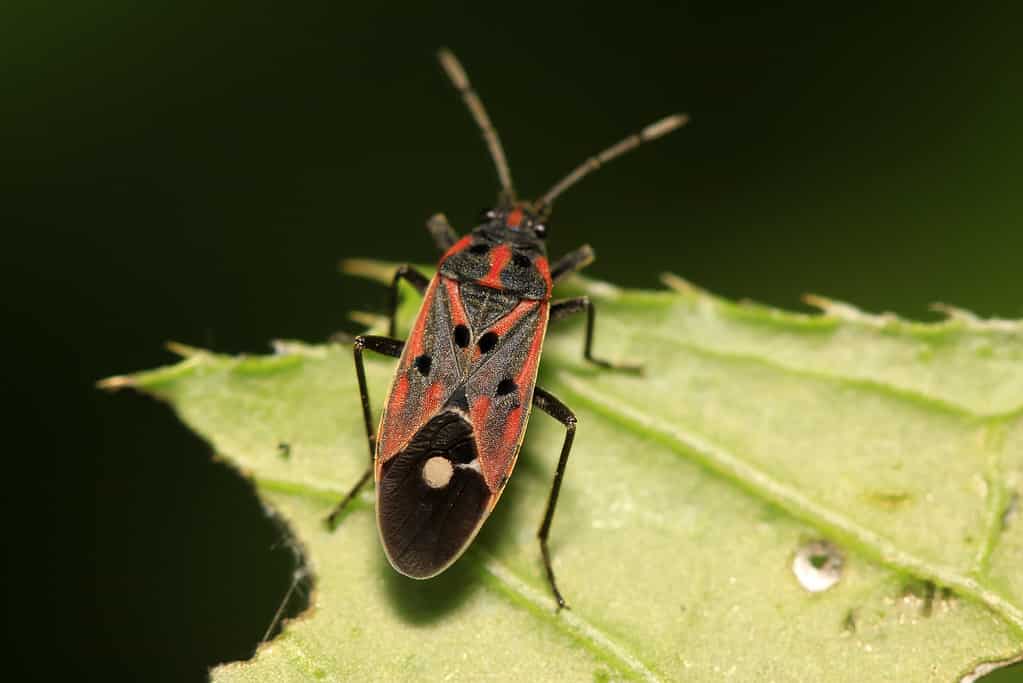
Chinch bugs are a common pest of crops in North America and have been causing damage as far back as 1780.
©chinahbzyg/Shutterstock.com
Black Flies (Simuliidae)
Black flies are notorious in New York for their painful bites that can pose a serious problem. During their active season, these pesky insects can gather in large swarms, making them hard to avoid. They use sharp mouthparts to break the skin and suck blood, making them a real nuisance.
Typically black or dark gray in color, black flies have delicate wings, stout legs, antennae, and short mouthparts designed for bloodsucking.
Only female black flies bite, and they can be so numerous that they are known to harm domestic animals, including chickens and birds. These insects are small, measuring slightly less than a quarter of an inch.
Black flies are diurnal, meaning they are only active during the day and do not bite at night. In upstate New York, they typically emerge in the spring and can pester residents until the end of June or mid-July.
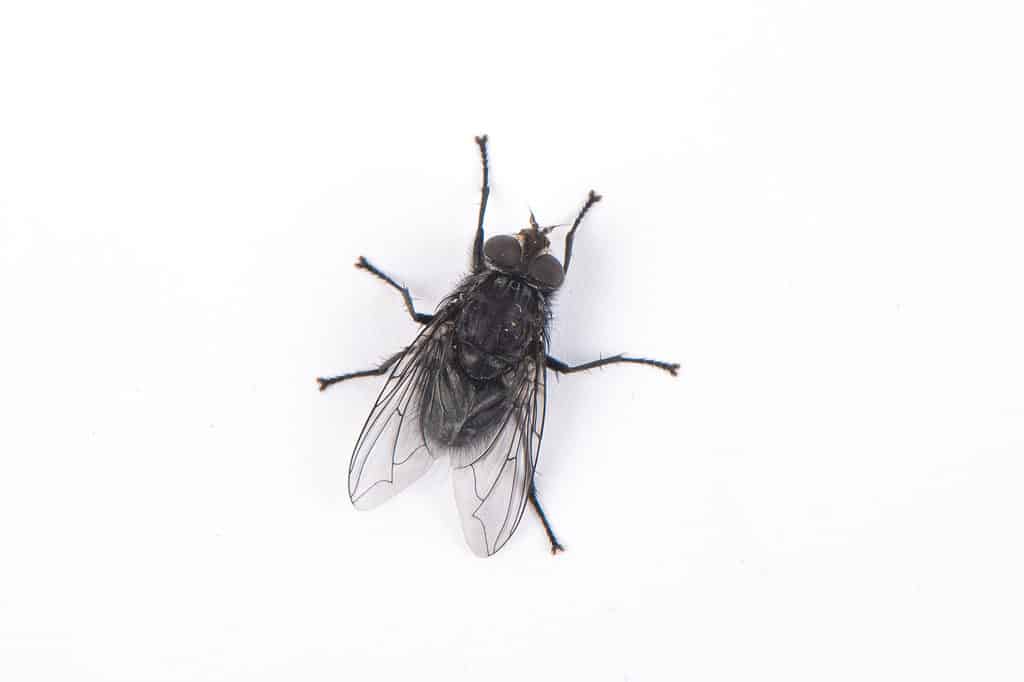
Black flies are infamous for their bites that cause itching, swelling, and inflammation.
©iStock.com/zhikun sun
Brown Marmorated Stink Bug (Halyomorpha halys)
The brown marmorated stink bug is the most common species of stink bug found in New York, with thousands of variations found worldwide. These insects have a distinctive shield-shaped body, six legs, and a pair of antennae, and they typically measure about an inch long.
These invasive bugs pose a dual threat as they can be a nuisance inside households and a significant agricultural pest outside. While the brown marmorated stink bug is not harmful to people, pets, or houses, it can cause considerable damage to crops.
Originally from Asia, the brown marmorated stink bug was first identified in North America in 2001, specifically in Pennsylvania. Since then, it has spread to most parts of the United States and become a severe pest that feeds on over a hundred plant species.
These bugs are most active in New York between spring and early fall, causing problems for homeowners and farmers alike.
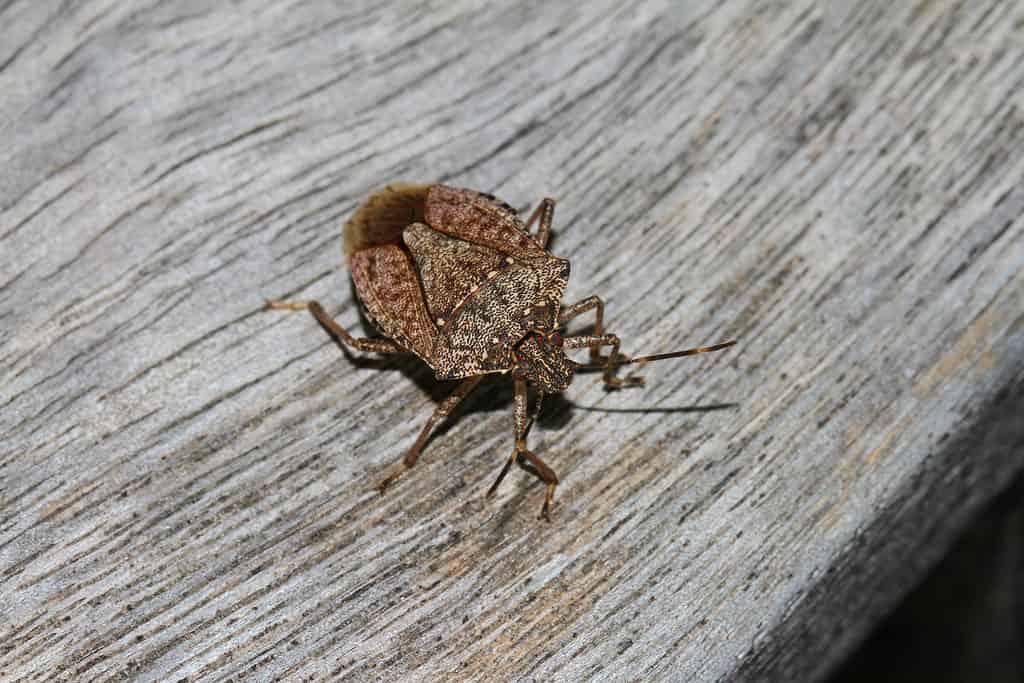
While the brown marmorated stink bug is not harmful to people, pets, or houses, it can cause considerable damage to crops.
©Ruth Swan/Shutterstock.com
European Gypsy Moth (Lymantria dispar dispar)
The European gypsy moth is an invasive insect species that poses a significant threat to New York’s ecosystem. These caterpillars cause widespread damage to the foliage of trees, shrubs, and other plants, disrupting people’s lives and altering ecosystems.
Originally native to temperate regions of Europe, Asia, and northern Africa, the North American population of gypsy moths largely stems from European origins. The first sighting of this species in North America dates back to 1869.
Gypsy moths are distinguishable by their distinct inverted V-shape and a dot marking on their wings. The male moths are smaller than the females, with feathery antennae, and have a dark brown hue. The females, on the other hand, have creamy white wings with a tan body. Despite having wings, female moths are incapable of flying.
The defoliation caused by gypsy moth caterpillars can weaken and damage a vast range of trees, including those in national forests and community landscapes in New York. These caterpillars can feed on at least 300 host species.
The adult gypsy moths typically emerge from their pupae within 10 to 14 days and are commonly seen between July and August.

The European gypsy moth is an invasive insect species that poses a significant threat to New York’s ecosystem.
©iStock.com/Wirestock
Summary of the Types of Ants Set to Emerge in New York
| # | Ant | Months Active |
|---|---|---|
| 1 | Citronella Ant | March-April/September-October |
| 2 | Odorous House Ant | Mach – October |
| 3 | Argentine Ant | May – September |
| 4 | Acrobat Ant | June – September |
| 5 | Carpenter Ant | March – September |
| 6 | Pavement Ant | March – September |
The photo featured at the top of this post is © iStock.com/macro frog insect animal
Thank you for reading! Have some feedback for us? Contact the AZ Animals editorial team.




